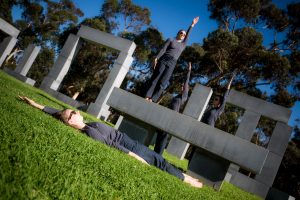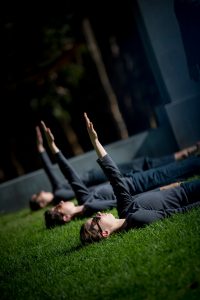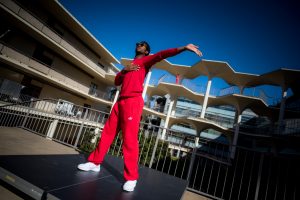‘Tis a Gift to Be Simple: Trisha Brown’s “In Plain Site”

Photo: Erik Jepsen/UC San Diego
“In Plain Site” is perfectly named. The work—a collection of pieces by Trisha Brown, reprised from landmark post-modern dance she created from 1968 to 1975—is site-specific, adapted to outdoor settings on the UCSD campus and enhancing one’s experience of architectural details, landscape, and the sight (and smell) of eucalyptus trees.
And “In Plain Site” is plain the way Shaker art or a Zen rock garden is plain: Brown stripped movement to its essence, creating series of clean, simple gestures, often performed in silence.
Gestures accumulate and repeat. In the first piece, called “Accumulation,” a solo dancer stands directly facing us, her arms at her sides. She extends one hand in a fist, thumb up like a hitchhiker, and rotates her forearm so the thumb goes back and forth. She adds the other hand/thumb. Then one arm comes forward. She layers on gestures (there are a total of thirty), then does the entire sequence several times. The only piece with music, this is done to the sweet harmonies of the Grateful Dead’s “Uncle John’s Band.” (You can see Brown herself doing it here.)
The dancer’s face remains quiet, as if she’s engaging a meditative practice. It’s simple and impeccable, and it moved me to tears. In Terpsichore in Sneakers, a brilliant book on post-modern dance by scholar Sally Banes, she uses the term “heroism of the ordinary.” Yes.
Leading us across the lawn, the company of eight dancers did “Leaning Duets,” walking in twos, holding hands, leaning out to counterbalance each other … but sometimes falling. There were also “Falling Duets,” where pairs of dancers faced each other, one began to fall, and the other ran to cushion the fall with his/her body. (A note about tense for the grammar-sensitive: I tend to use present tense to focus on choreography and past for a specific performance.)

Photo: Erik Jepsen/UC San Diego
“Group Primary Accumulation” took place at the La Jolla Project sculpture by Richard Fleischner (popularly known as Stonehenge). The four women lay on their backs on the grass in front of the sculpture, in a front-to-back row. With no musical cues, they did a gestural sequence in unison. From time to time, the men came over from the side and moved the dancers into different positions—sitting, standing on a piece of the sculpture, etc. Even as the women were being carried, they kept the sequence going.
This may sound like watching grass grow, but it was yummy! Critic Joan Acocella has written that part of our response to dance is neurochemical—seeing certain movements or ways in which groups of dancers are deployed in space, we’re hardwired to appreciate them—and my synapses felt happy.
There were two solos with props, a man balancing a stick on his head as he slowly came from standing to the ground, and a woman doing an increasingly vigorous sequence on a low platform (which looked a lot like the platform in 4×4).
For the final work, Brown’s iconic “Roof Piece,” we changed locations, to the breezeway between Bonner and Mayer Halls. And the dancers changed clothes. Previously, they’d worn simple gray shirts and draw-string pants. Now one of the men appeared in bright red, stood on a platform in the center of the breezeway, and began to do a series of gestures.

Photo: Erik Jepsen/UC San Diego
But wait! Scattered around the breezeway—on a third-floor balcony over here, a fourth-floor balcony there—were dancers doing the same gestures, but all starting at slightly different times; in fact, each one had another from whom they picked up the gesture. And all eight were there, though it took some looking to discover the woman underneath a walkway or the person on a far balcony, a moment that brought a sense of exuberance, like finding something in a treasure hunt.
“In Plain Site” was presented by UCSD ArtPower and offered as part of the La Jolla Playhouse Wow Festival. And it was truly wow. Fresh and fun and inventive, for all that this work has gone from its radical beginnings to being part of the dance canon.
It was also a remarkable slice of dance history, in part because Brown died last March at age 80. It was also that, at the show I attended (Saturday, 2 p.m.), the audience was filled with people who’ve shaped modern dance in San Diego—I’ll mention just Pat Sandback and Jean Isaacs, but every time I turned around, I saw another dance artist/teacher. It felt as if everyone had come to drink from the source.

Award-winning dance journalist Janice Steinberg has published more than 400 articles in the San Diego Union-Tribune, Dance Magazine, the Los Angeles Times, and elsewhere. She was a 2004 New York Times-National Endowment for the Arts fellow at the Institute for Dance Criticism and has taught dance criticism at San Diego State University. She is also a novelist, author of The Tin Horse (Random House, 2013). For why she’s passionate about dance, see this article on her web site, The Tin Horse
